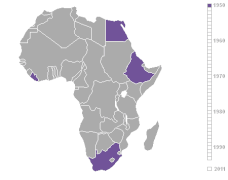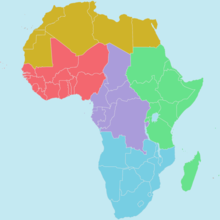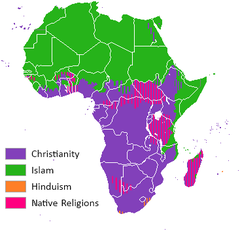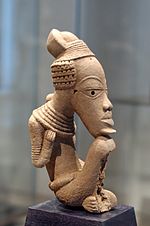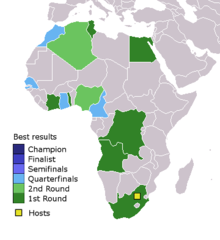Politics Of Africa
The continent is surrounded by the Mediterranean Sea to the north, the Arabian Plate and the Gulf of Aqaba to the northeast, the Indian Ocean to the southeast and the Atlantic Ocean to the west. The continent includes Madagascar and various archipelagos. It contains 54 fully recognised sovereign states, eight cities and islands that are part of non-African states, and two de facto independent states with limited or no recognition. This count does not include Malta and Sicily, which are geologically part of the African continent. Algeria is Africa's largest country by area, and Nigeria is its largest by population. African nations cooperate through the establishment of the African Union, which is headquartered in Addis Ababa.
Africa straddles the equator and the prime meridian. It is the only continent to stretch from the northern temperate to the southern temperate zones. The majority of the continent and its countries are in the Northern Hemisphere, with a substantial portion and a number of countries in the Southern Hemisphere. Most of the continent lies in the tropics, except for a large part of Western Sahara, Algeria, Libya and Egypt, the northern tip of Mauritania, and the entire territories of Morocco and Tunisia, which in turn are located above the tropic of Cancer, in the northern temperate zone. In the other extreme of the continent, southern Namibia, southern Botswana, great parts of South Africa, the entire territories of Lesotho and Eswatini and the southern tips of Mozambique and Madagascar are located below the tropic of Capricorn, in the southern temperate zone.
Africa is highly biodiverse; it is the continent with the largest number of megafauna species, as it was least affected by the extinction of the Pleistocene megafauna. However, Africa also is heavily affected by a wide range of environmental issues, including desertification, deforestation, water scarcity, and pollution. These entrenched environmental concerns are expected to worsen as climate change impacts Africa. The UN Intergovernmental Panel on Climate Change has identified Africa as the continent most vulnerable to climate change.
The history of Africa is long, complex, and varied, and has often been under-appreciated by the global historical community. In African societies the oral word is revered, and they have generally recorded their history via oral tradition, which has led anthropologists to term them oral civilisations, contrasted with literate civilisations which pride the written word. During the colonial period, oral sources were deprecated by European historians, which gave them the impression Africa had no recorded history. African historiography became organized at the academic level in the mid-20th century, and saw a movement towards utilising oral sources in a multidisciplinary approach, culminating in the General History of Africa, edited by specialists from across the continent.
Africa, particularly Eastern Africa, is widely accepted to be the place of origin of humans and the Hominidae clade, also known as the great apes. The earliest hominids and their ancestors have been dated to around 7 million years ago, and Homo sapiens (modern human) are believed to have originated in Africa 350,000 to 260,000 years ago. Africa is also considered by anthropologists to be the most genetically diverse continent as a result of being the longest inhabited. In the 4th and 3rd millennia BC Ancient Egypt, Kerma, Punt, and the Tichitt Tradition emerged in North, East and West Africa, while from 4000 BC until 1000 AD the Bantu expansion was substantial in laying the foundations for societies and states in Central, East, and Southern Africa. Some African empires include Wagadu, Mali, Songhai, Sokoto, Ife, Benin, Asante, the Fatimids, Almoravids, Almohads, Ayyubids, Mamluks, Kongo, Mwene Muji, Luba, Lunda, Kitara, Aksum, Ethiopia, Adal, Ajuran, Kilwa, Sakalava, Imerina, Maravi, Mutapa, Rozvi, Mthwakazi, and Zulu. Slave trades created various diasporas, especially in the Americas. From the late 19th century to early 20th century, driven by the Second Industrial Revolution, most of Africa was rapidly conquered and colonised by European nations, save for Ethiopia and Liberia. European rule had significant impacts on Africa's societies, and colonies were maintained for the purpose of economic exploitation and extraction of natural resources. Most present states emerged from a process of decolonisation following World War II, and established the Organisation of African Unity in 1963, the predecessor to the African Union. The nascent countries decided to keep their colonial borders, with traditional power structures used in governance to varying degrees.
Etymology
Afri was a Latin name used to refer to the inhabitants of what was then known as northern Africa, located west of the Nile river, and in its widest sense referring to all lands south of the Mediterranean, also known as Ancient Libya. This name seems to have originally referred to a native Libyan tribe, an ancestor of modern Berbers; see Terence for discussion. The name had usually been connected with the Phoenician word ʿafar meaning "dust", but a 1981 hypothesis has asserted that it stems from the Berber word ifri (plural ifran) meaning "cave", in reference to cave dwellers. The same word may be found in the name of the Banu Ifran from Algeria and Tripolitania, a Berber tribe originally from Yafran (also known as Ifrane) in northwestern Libya, as well as the city of Ifrane in Morocco.
Under Roman rule, Carthage became the capital of the province then named Africa Proconsularis, following its defeat of the Carthaginians in the Third Punic War in 146 BC, which also included the coastal part of modern Libya. The Latin suffix -ica can sometimes be used to denote a land (e.g., in Celtica from Celtae, as used by Julius Caesar). The later Muslim region of Ifriqiya, following its conquest of the Byzantine (Eastern Roman) Empire's Exarchatus Africae, also preserved a form of the name.
According to the Romans, Africa lies to the west of Egypt, while "Asia" was used to refer to Anatolia and lands to the east. A definite line was drawn between the two continents by the geographer Ptolemy (85–165 CE), indicating Alexandria along the Prime Meridian and making the isthmus of Suez and the Red Sea the boundary between Asia and Africa. As Europeans came to understand the real extent of the continent, the idea of "Africa" expanded with their knowledge.
Other etymological hypotheses have been postulated for the ancient name "Africa":
- The 1st-century Jewish historian Flavius Josephus (Ant. 1.15) asserted that it was named for Epher, grandson of Abraham according to Gen. 25:4, whose descendants, he claimed, had invaded Libya.
- Isidore of Seville in his 7th-century Etymologiae XIV.5.2. suggests "Africa" comes from the Latin aprica, meaning "sunny".
- Massey, in 1881, stated that Africa is derived from the Egyptian af-rui-ka, meaning "to turn toward the opening of the Ka." The Ka is the energetic double of every person and the "opening of the Ka" refers to a womb or birthplace. Africa would be, for the Egyptians, "the birthplace."
- Michèle Fruyt in 1976 proposed linking the Latin word with africus "south wind", which would be of Umbrian origin and mean originally "rainy wind".
- Robert R. Stieglitz of Rutgers University in 1984 proposed: "The name Africa, derived from the Latin *Aphir-ic-a, is cognate to Hebrew Ophir ['rich']."
- Ibn Khallikan and some other historians claim that the name of Africa came from a Himyarite king called Afrikin ibn Kais ibn Saifi ("Afrikus son of Abraham") who subdued Ifriqiya.
- Arabic afrīqā (feminine noun) and ifrīqiyā, now usually pronounced afrīqiyā (feminine) 'Africa', from 'afara [' = 'ain, not 'alif] 'to be dusty' from 'afar 'dust, powder' and 'afir 'dried, dried up by the sun, withered' and 'affara 'to dry in the sun on hot sand' or 'to sprinkle with dust'.
- Possibly Phoenician faraqa in the sense of 'colony, separation'.
History
History in Africa
In African societies, the historical process is largely a communal one, with eyewitness accounts, hearsay, reminiscences, and occasionally visions, dreams, and hallucinations crafted into narrative oral traditions which are performed and transmitted through generations. Time is sometimes mythical and social, and truth generally viewed as relativist. In African epistemology, the epistemic subject "experiences the epistemic object in a sensuous, emotive, intuitive, abstractive understanding, rather than through abstraction alone, as is the case in Western epistemology" to arrive at a "complete knowledge", and as such oral traditions, music, proverbs, and the like were used in the preservation and transmission of knowledge. Oral tradition can be exoteric or esoteric. It speaks to people according to their understanding, unveiling itself in accordance with their aptitudes. In studying traditions, historians consider the role the mind and memory has in shaping a tradition. The concrete, rather than the abstract, is often remembered as events are crystallised into clichés over time.
Prehistory

Africa is considered by most paleoanthropologists to be the oldest inhabited territory on Earth, with the Human species originating from the continent. During the mid-20th century, anthropologists discovered many fossils and evidence of human occupation perhaps as early as seven million years ago (Before present, BP). Fossil remains of several species of early apelike humans thought to have evolved into modern humans, such as Australopithecus afarensis radiometrically dated to approximately 3.9–3.0 million years BP, Paranthropus boisei (c. 2.3–1.4 million years BP) and Homo ergaster (c. 1.9 million–600,000 years BP) have been discovered.
After the evolution of Homo sapiens approximately 350,000 to 260,000 years BP in Africa, the continent was mainly populated by groups of hunter-gatherers. These first modern humans left Africa and populated the rest of the globe during the Out of Africa II migration dated to approximately 50,000 years BP, exiting the continent either across Bab-el-Mandeb over the Red Sea, the Strait of Gibraltar in Morocco, or the Isthmus of Suez in Egypt.
Other migrations of modern humans within the African continent have been dated to that time, with evidence of early human settlement found in Southern Africa, Southeast Africa, North Africa, and the Sahara.
Emergence of civilization
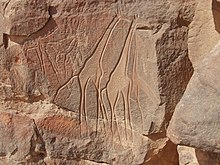

The size of the Sahara has historically been extremely variable, with its area rapidly fluctuating and at times disappearing depending on global climatic conditions. At the end of the Ice ages, estimated to have been around 10,500 BC, the Sahara had again become a green fertile valley, and its African populations returned from the interior and coastal highlands in sub-Saharan Africa, with rock art paintings depicting a fertile Sahara and large populations discovered in Tassili n'Ajjer dating back perhaps 10 millennia. However, the warming and drying climate meant that by 5,000 BC, the Sahara region was becoming increasingly dry and hostile. Around 3500 BC, due to a tilt in the Earth's orbit, the Sahara experienced a period of rapid desertification. The population trekked out of the Sahara region towards the Nile Valley below the Second Cataract where they made permanent or semi-permanent settlements. A major climatic recession occurred, lessening the heavy and persistent rains in Central and Eastern Africa. Since this time, dry conditions have prevailed in Eastern Africa and, increasingly during the last 200 years, in Ethiopia.
The domestication of cattle in Africa preceded agriculture and seems to have existed alongside hunter-gatherer cultures. It is speculated that by 6,000 BC, cattle were domesticated in North Africa. In the Sahara-Nile complex, people domesticated many animals, including the donkey and a small screw-horned goat that was common from Algeria to Nubia. Between 10,000 and 9,000 BC, pottery was independently invented in the region of Mali in the savannah of West Africa. In the steppes and savannahs of the Sahara and Sahel in Northern West Africa, people possibly ancestral to modern Nilo-Saharan and Mandé cultures started to collect wild millet, around 8,000 to 6,000 BC. Later, gourds, watermelons, castor beans, and cotton were also collected. Sorghum was first domesticated in Eastern Sudan around 4,000 BC, in one of the earliest instances of agriculture in human history. Its cultivation would gradually spread across Africa, before spreading to India around 2000 BC.
People around modern-day Mauritania started making pottery and built stone settlements (e.g., Tichitt, Oualata). Fishing, using bone-tipped harpoons, became a major activity in the numerous streams and lakes formed from the increased rains. In West Africa, the wet phase ushered in an expanding rainforest and wooded savanna from Senegal to Cameroon. Between 9,000 and 5,000 BC, Niger–Congo speakers domesticated the oil palm and raffia palm. Black-eyed peas and voandzeia (African groundnuts), were domesticated, followed by okra and kola nuts. Since most of the plants grew in the forest, the Niger–Congo speakers invented polished stone axes for clearing forest.
Around 4,000 BC, the Saharan climate started to become drier at an exceedingly fast pace. This climate change caused lakes and rivers to shrink significantly and caused increasing desertification. This, in turn, decreased the amount of land conducive to settlements and encouraged migrations of farming communities to the more tropical climate of West Africa. During the first millennium BC, a reduction in wild grain populations related to changing climate conditions facilitated the expansion of farming communities and the rapid adoption of rice cultivation around the Niger River.
By the first millennium BC, ironworking had been introduced in Northern Africa. Around that time it also became established in parts of sub-Saharan Africa, either through independent invention there or diffusion from the north and vanished under unknown circumstances around 500 AD, having lasted approximately 2,000 years, and by 500 BC, metalworking began to become commonplace in West Africa. Ironworking was fully established by roughly 500 BC in many areas of East and West Africa, although other regions did not begin ironworking until the early centuries AD. Copper objects from Egypt, North Africa, Nubia, and Ethiopia dating from around 500 BC have been excavated in West Africa, suggesting that Trans-Saharan trade networks had been established by this date.
4th millennium BC – 6th century AD
Northeast Africa
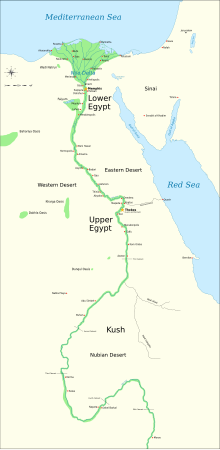
From 3500 BC, nomes (ruled by nomarchs) coalesced to form the kingdoms of Lower Egypt and Upper Egypt in northeast Africa. Around 3100 BC Upper Egypt conquered Lower Egypt to unify Egypt under the 1st dynasty, with the process of consolidation and assimilation completed by the time of the 3rd dynasty who formed the Old Kingdom of Egypt in 2686 BC. The Kingdom of Kerma emerged around this time to become the dominant force in Nubia, controlling territory as large as Egypt between the 1st and 4th cataracts of the Nile.
The 4th dynasty oversaw the height of the Old Kingdom, and constructed many great pyramids. Under the 6th dynasty power gradually decentralised to the nomarchs, culminating in the disintegration of the kingdom, exacerbated by drought and famine, thus commencing the First Intermediate Period in 2200 BC. This shattered state would last until 2055 BC when the 11th dynasty, based in Thebes, conquered the others to form the Middle Kingdom of Egypt, with the 12th dynasty expanding into Lower Nubia at the expense of Kerma. In 1700 BC, the Middle Kingdom fractured in two, ushering in the Second Intermediate Period. The Hyksos, a militaristic people from Palestine, invaded and conquered Lower Egypt, while Kerma coordinated invasions deep into Egypt to reach its greatest extent.
In 1550 BC, the 18th dynasty expelled the Hyksos, and established the New Kingdom of Egypt. Using the advanced military technology the Hyksos had brought, the New Kingdom conquered the Levant from the Canaanites, Mittani, Amorites, and Hittites, and extinguished Kerma, incorporating Nubia into the empire, and sending the Egyptian empire into its golden age. Internal struggles, drought, famine, and invasions by a confederation of seafaring peoples contributed to the New Kingdom's collapse in 1069 BC, commencing the Third Intermediate Period.
Egypt's collapse liberated the more Egyptianised Kingdom of Kush in Nubia, who manoeuvred into power in Upper Egypt and conquered Lower Egypt in 754 BC to form the Kushite Empire. The Kushites ruled for a century and oversaw a revival in pyramid building, until they were driven out of Egypt by the Assyrians in 663 BC in reprisal for their expansion towards the Assyrian Empire. The Assyrians installed a puppet dynasty that later gained independence and once more unified Egypt, until they were conquered by the Achaemenid Empire in 525 BC. Egypt regained independence under the 28th dynasty in 404 BC but they were reconquered by the Achaemenids in 343 BC. The conquest of Achaemenid Egypt by Alexander the Great in 332 BC marked the beginning of Hellenistic rule and the installation of the Macedonian Ptolemaic dynasty in Egypt.
The Ptolemaics lost their holdings outside of Africa to the Seleucids in the Syrian Wars, expanded into Cyrenaica and subjugated Kush in the 3rd century BC. In the 1st century BC, Ptolemaic Egypt became entangled in a Roman civil war, leading to its conquest by the Romans in 30 BC. The Crisis of the Third Century in the Roman Empire freed the Levantine city state of Palmyra, which conquered Egypt; their brief rule ended when they were reconquered by the Romans. In the midst of this, Kush regained independence from Egypt, and they would persist as a major regional power until, having been weakened from internal rebellion amid worsening climatic conditions, invasions by Aksum and the Noba caused their disintegration into Makuria, Alodia, and Nobatia in the 5th century AD. The Romans managed to hold on to Egypt for the rest of the ancient period.
Horn of Africa

In the Horn of Africa, there was the Land of Punt, a kingdom on the Red Sea, likely located in modern-day Eritrea or northern Somaliland. The Ancient Egyptians initially traded via middle-men with Punt until in 2350 BC when they established direct relations. They would become close trading partners for over a millennium. Towards the end of the ancient period, northern Ethiopia and Eritrea bore the Kingdom of D'mt beginning in 980 BC. In modern-day Somalia and Djibouti there was the Macrobian Kingdom, with archaeological discoveries indicating the possibility of other unknown sophisticated civilisations at this time. After D'mt's fall in the 5th century BC the Ethiopian Plateau came to be ruled by numerous smaller unknown kingdoms who experienced strong south Arabian influence, until the growth and expansion of Aksum in the 1st century BC. Along the Horn's coast there were many ancient Somali city-states that thrived off of the wider Red Sea trade and transported their cargo via beden, exporting myrrh, frankincense, spices, gum, incense, and ivory, with freedom from Roman interference causing Indians to give the cities a lucrative monopoly on cinnamon from ancient India.
The Kingdom of Aksum grew from a principality into a major power on the trade route between Rome and India through conquering its unfortunately unknown neighbours, gaining a monopoly on Indian Ocean trade in the region. Aksum's rise had them rule over much of the regions from Lake Tana to the valley of the Nile, and they further conquered parts of the ailing Kingdom of Kush, led campaigns against the Noba and Beja peoples, and expanded into South Arabia. This led the Persian prophet Mani to consider Aksum as one of the four great powers of the 3rd century AD alongside Persia, Rome, and China. In the 4th century AD Aksum's king converted to Christianity and Aksum's population, who had followed syncretic mixes of local beliefs, slowly followed. The end of the 5th century saw Aksum allied with the Byzantine Empire, who viewed themselves as defenders of Christendom, balanced against the Sassanid Empire and the Himyarite Kingdom in Arabia.
Northwest Africa


The Maghreb and Ifriqiya were mostly cut off from the cradle of civilisation in Egypt by the Libyan desert, exacerbated by Egyptian boats being tailored to the Nile and not coping well in the open Mediterranean Sea. This caused its societies to develop contiguous to those of Southern Europe, until Phoenician settlements came to dominate the most lucrative trading locations in the Gulf of Tunis. Phoenician settlements subsequently grew into Ancient Carthage after gaining independence from Phoenicia in the 6th century BC, and they would build an extensive empire and a strict mercantile network, all secured by one of the largest and most powerful navies in the ancient Mediterranean. Carthage would meet its demise in the Punic Wars against the expansionary Roman Republic, however momentum in these wars was not linear, with Carthage initially experiencing considerable success in the Second Punic War following Hannibal's infamous crossing of the alps into northern Italy. Their defeat and subsequent collapse of their empire would produce two further polities in the Maghreb; Numidia, which had assisted the Romans in the Second Punic War, Mauretania, a Mauri tribal kingdom and home of the legendary King Atlas, and various tribes such as Garamantes, Musulamii, and Bavares. The Third Punic War would result in Carthage's total defeat in 146 BC and the Romans established the province of Africa, with Numidia assuming control of many of Carthage's African ports. Towards the end of the 2nd century BC Mauretania fought alongside Numidia's Jugurtha in the Jugurthine War against the Romans after he had usurped the Numidian throne from a Roman ally. Together they inflicted heavy casualties that quaked the Roman Senate, with the war only ending inconclusively when Mauretania's Bocchus I sold out Jugurtha to the Romans.
At the turn of the millennium, they both would face the same fate as Carthage and be conquered by the Romans who established Mauretania and Numidia as provinces of their empire, while Musulamii, led by Tacfarinas, and Garamantes were eventually defeated in war in the 1st century AD however weren't conquered. In the 5th century AD the Vandals conquered north Africa precipitating the fall of Rome. Swathes of indigenous peoples would regain self-governance in the Mauro-Roman Kingdom and its numerous successor polities in the Maghreb, namely the kingdoms of Ouarsenis, Aurès, and Altava. The Vandals ruled Ifriqiya for a century until Byzantine reconquest in the early 6th century AD. The Byzantines and the Berber kingdoms fought minor inconsequential conflicts, such as in the case of Garmul, however largely coexisted. Further inland to the Byzantine Exarchate of Africa were the Sanhaja in modern-day Algeria, a broad grouping of three groupings of tribal confederations, one of which is the Masmuda grouping in modern-day Morocco, along with the nomadic Zenata; their composite tribes would later go onto shape much of North African history.
West Africa


In the western Sahel the rise of settled communities occurred largely as a result of the domestication of millet and of sorghum. Archaeology points to sizable urban populations in West Africa beginning in the 4th millennium BC, which had crucially developed iron metallurgy by 1200 BC, in both smelting and forging for tools and weapons. Extensive east-west belts of deserts, grasslands, and forests from north to south were crucial for the moulding of their respective societies and meant that prior to the accession of trans-Saharan trade routes, symbiotic trade relations developed in response to the opportunities afforded by north–south diversity in ecosystems. Various civilisations prospered in this period. From 4000 BC, the Tichitt culture in modern-day Mauritania and Mali was the oldest known complexly organised society in West Africa, with a four tiered hierarchical social structure. Other civilisations include the Kintampo culture from 2500 BC in modern-day Ghana, the Nok culture from 1500 BC in modern-day Nigeria, the Daima culture around Lake Chad from 550 BC, Djenné-Djenno from 250 BC in modern-day Mali, and the Serer civilisation in modern-day Senegal, which built the Senegambian stone circles from the 3rd century BC. There is also detailed record of Igodomigodo, a small kingdom founded presumably in 40 BC, which would later go on to form the Benin Empire.
Towards the end of the 3rd century AD, a wet period in the Sahel created areas for human habitation and exploitation that had not been habitable for the best part of a millennium, with the Kingdom of Wagadu, the local name of the Ghana Empire, rising out of the Tichitt culture, growing wealthy following the introduction of the camel to the western Sahel, revolutionising the trans-Saharan trade that linked their capital and Aoudaghost with Tahert and Sijilmasa in North Africa. Soninke traditions likely contain content from prehistory, mentioning four previous foundings of Wagadu, and holds that the final founding of Wagadu occurred after their first king did a deal with Bida, a serpent deity who was guarding a well, to sacrifice one maiden a year in exchange for assurance regarding plenty of rainfall and gold supply. Wagadu's core traversed modern-day southern Mauritania and western Mali, and Soninke tradition portrays early Ghana as warlike, with horse-mounted warriors key to increasing its territory and population, although details of their expansion are extremely scarce. Wagadu made its profits from maintaining a monopoly on gold heading north and salt heading south, despite not controlling the gold fields themselves, located in the forest regions. It is probable that Wagadu's dominance on trade allowed for the gradual consolidation of many polities into a confederated state, whose composites stood in varying relations to the core, from fully administered to nominal tribute-paying parity. Based on large tumuli scattered across West Africa dating to this period, it has been stipulated that relative to Wagadu, there were further simultaneous and preceding kingdoms that have unfortunately been lost to time.
Central, Eastern, and Southern Africa

1 = 2000–1500 BC origin
2 = c. 1500 BC first dispersal
2.a = Eastern Bantu
2.b = Western Bantu
3 = 1000–500 BC Urewe nucleus of Eastern Bantu
4–7 = southward advance
9 = 500–1 BC Congo nucleus
10 = AD 1–1000 last phase
At the 4th millennium BC the Congo Basin was inhabited by the Bambenga, Bayaka, Bakoya, and Babongo in the west, the Bambuti in the east, and the Batwa who were widely scattered and also present in the Great Lakes region; together they are grouped as Pygmies. On the later-named Swahili coast there were Cushitic-speaking peoples, and the Khoisan (a neologism for the Khoekhoe and San) in the continent's south.
The Bantu expansion constituted a major series of migrations of Bantu peoples from central Africa to eastern and southern Africa and was substantial in the settling of the continent. Commencing in the 2nd millennium BC, the Bantu began to migrate from Cameroon to central, eastern, and southern Africa, laying the foundations for future states such as the Kingdom of Kongo in the Congo Basin, the Empire of Kitara in the African Great Lakes, the Luba Empire in the Upemba Depression, the Kilwa Sultanate in the Swahili coast by crowding out Azania, with Rhapta being its last stronghold by the 1st century AD. These migrations also prefaced the Kingdom of Mapungubwe in the Zambezi basin. After reaching the Zambezi, the Bantu continued southward, with eastern groups continuing to modern-day Mozambique and reaching Maputo in the 2nd century AD. Further to the south, settlements of Bantu peoples who were iron-using agriculturists and herdsmen were well established south of the Limpopo River by the 4th century AD, displacing and absorbing the Khoisan.
By the Chari River south of Lake Chad the Sao civilisation flourished for over a millennium beginning in the 6th century BC, in territory that later became part of present-day Cameroon and Chad. Sao artifacts show that they were skilled workers in bronze, copper, and iron, with finds including bronze sculptures, terracotta statues of human and animal figures, coins, funerary urns, household utensils, jewellery, highly decorated pottery, and spears. Nearby, around Lake Ejagham in south-west Cameroon, the Ekoi civilisation rose circa 2nd century AD, and are most notable for constructing the Ikom monoliths and developing the Nsibidi script.
9th to 18th centuries

Pre-colonial Africa possessed as many as 10,000 different states and polities. These included small family groups of hunter-gatherers such as the San people of southern Africa; larger, more structured groups such as the family clan groupings of the Bantu peoples of central, southern, and eastern Africa; heavily structured clan groups in the Horn of Africa; the large Sahelian kingdoms; and autonomous city-states and kingdoms, such as those of the Akan; Edo, Yoruba, and Igbo people in West Africa; and the Swahili coastal trading towns of Southeast Africa.
By the 9th century AD, a string of dynastic states, including the earliest Hausa states, stretched across the sub-Saharan savannah from the western regions to central Sudan. The most powerful of these states were Ghana, Gao, and the Kanem-Bornu Empire. Ghana declined in the eleventh century, but was succeeded by the Mali Empire, which consolidated much of western Sudan in the thirteenth century. Kanem accepted Islam in the eleventh century.
In the forested regions of the West African coast, independent kingdoms grew with little influence from the Muslim north. The Kingdom of Nri, which was ruled by the Eze Nri, was established around the ninth century, making it one of the oldest kingdoms in present-day Nigeri. The Nri kingdom is famous for its elaborate bronzes, found at the town of Igbo-Ukwu.

The Kingdom of Ife, historically the first of these Yoruba city-states or kingdoms, established government under a priestly oba ('king' or 'ruler' in the Yoruba language), called the Ooni of Ife. Ife was noted as a major religious and cultural centre in West Africa and for its unique naturalistic tradition of bronze sculpture. The Ife model of government was adapted by the Oyo Empire, whose obas, called the Alaafins of Oyo, controlled many other Yoruba and non-Yoruba city-states and kingdoms including the Fon Kingdom of Dahomey.
The Almoravids were a Berber dynasty from the Sahara that spread over northwestern Africa and the Iberian peninsula during the eleventh century. The Banu Hilal and Banu Ma'qil were a collection of Arab Bedouin tribes from the Arabian Peninsula who migrated westwards via Egypt between the eleventh and thirteenth centuries. Their migration resulted in the fusion of the Arabs and Berbers, where the locals were Arabized, and Arab culture absorbed elements of the local culture, under the unifying framework of Islam.
Following the breakup of Mali, a local leader named Sonni Ali (1464–1492) founded the Songhai Empire in the region of middle Niger and the western Sudan and took control of the trans-Saharan trade. Sonni Ali seized Timbuktu in 1468 and Jenne in 1473, building his regime on trade revenues and the cooperation of Muslim merchants. His successor Askia Mohammad I (1493–1528) made Islam the official religion, built mosques, and brought to Gao Muslim scholars, including al-Maghili (d.1504), the founder of an important tradition of Sudanic African Muslim scholarship. By the eleventh century, some Hausa states – such as Kano, Jigawa, Katsina, and Gobir – had developed into walled towns engaging in trade, servicing caravans, and the manufacture of goods. Until the fifteenth century, these small states were on the periphery of the major Sudanic empires of the era, paying tribute to Songhai to the west and Kanem-Borno to the east.
Height of the slave trade

Slavery had long been practiced in Africa. Between the 15th and the 19th centuries, the Atlantic slave trade took an estimated 7–12 million slaves to the New World. In addition, more than 1 million Europeans were captured by Barbary pirates and sold as slaves in North Africa between the 16th and 19th centuries.
In West Africa, the decline of the Atlantic slave trade in the 1820s caused dramatic economic shifts in local polities. The gradual decline of slave-trading, prompted by a lack of demand for slaves in the New World, increasing anti-slavery legislation in Europe and America, and the British Royal Navy's increasing presence off the West African coast, obliged African states to adopt new economies. Between 1808 and 1860, the British West Africa Squadron seized approximately 1,600 slave ships and freed 150,000 Africans who were aboard.
Action was also taken against African leaders who refused to agree to British treaties to outlaw the trade, for example against "the usurping King of Lagos", deposed in 1851. Anti-slavery treaties were signed with over 50 African rulers. The largest powers of West Africa (the Asante Confederacy, the Kingdom of Dahomey, and the Oyo Empire) adopted different ways of adapting to the shift. Asante and Dahomey concentrated on the development of "legitimate commerce" in the form of palm oil, cocoa, timber and gold, forming the bedrock of West Africa's modern export trade. The Oyo Empire, unable to adapt, collapsed into civil wars.
Colonialism
The Scramble for Africa was the conquest and colonisation of most of Africa by seven Western European powers driven by the Second Industrial Revolution during the late 19th century and early 20th century in the era of "New Imperialism": Belgium, France, Germany, United Kingdom, Italy, Portugal and Spain.
In 1870, 10% of the continent was formally under European control. By 1914, this figure had risen to almost 90%; the only states retaining sovereignty were Liberia, Ethiopia, Egba, Aussa, Senusiyya, Mbunda, the Dervish State, and the Ovambo kingdoms, most of which were later conquered.
The 1884 Berlin Conference regulated European colonisation and trade in Africa, and is seen as emblematic of the "scramble". In the last quarter of the 19th century, there were considerable political rivalries between the European empires, which provided the impetus for the colonisation. The later years of the 19th century saw a transition from "informal imperialism" – military influence and economic dominance – to direct rule.
With the decline of the European colonial empires in the wake of the two world wars, most African colonies gained independence during the Cold War, and decided to keep their colonial borders in the Organisation of African Unity conference of 1964 due to fears of civil wars and regional instability, placing emphasis on pan-Africanism.Independence struggles

Imperial rule by Europeans continued until after the conclusion of World War II, when almost all remaining colonial territories gradually obtained formal independence. Independence movements in Africa gained momentum following World War II, which left the major European powers weakened. In 1951, Libya, a former Italian colony, gained independence. In 1956, Tunisia and Morocco won their independence from France. Ghana followed suit the next year (March 1957), becoming the first of the sub-Saharan colonies to be granted independence. Over the next decade, waves of decolonization took place across the continent, culminating in the 1960 Year of Africa and the establishment of the Organisation of African Unity in 1963.
Portugal's overseas presence in sub-Saharan Africa (most notably in Angola, Cape Verde, Mozambique, Guinea-Bissau, and São Tomé and Príncipe) lasted from the 16th century to 1975, after the Estado Novo regime was overthrown in a military coup in Lisbon. Rhodesia unilaterally declared independence from the United Kingdom in 1965, under the white minority government of Ian Smith, but was not internationally recognized as an independent state (as Zimbabwe) until 1980, when black nationalists gained power after a bitter guerrilla war. Although South Africa was one of the first African countries to gain independence, the state remained under the control of the country's white minority, initially through qualified voting rights and from 1956 by a system of racial segregation known as apartheid, until 1994.
Post-colonial Africa
Today, Africa contains 54 sovereign countries. Since independence, African states have frequently been hampered by instability, corruption, violence, and authoritarianism. The vast majority of African states are republics that operate under some form of the presidential system of rule. However, few of them have been able to sustain democratic governments on a permanent basis—per the criteria laid out by Lührmann et al. (2018), only Botswana and Mauritius have been consistently democratic for the entirety of their post-colonial history. Most African countries have experienced several coups or periods of military dictatorship. Between 1990 and 2018, though, the continent as a whole has trended towards more democratic governance.
Upon independence an overwhelming majority of Africans lived in extreme poverty. The continent suffered from the lack of infrastructural or industrial development under colonial rule, along with political instability. With limited financial resources or access to global markets, relatively stable countries such as Kenya still experienced only very slow economic development. Only a handful of African countries succeeded in obtaining rapid economic growth prior to 1990. Exceptions include Libya and Equatorial Guinea, both of which possess large oil reserves.
Instability throughout the continent after decolonization resulted primarily from marginalization of ethnic groups, and corruption. In pursuit of personal political gain, many leaders deliberately promoted ethnic conflicts, some of which had originated during the colonial period, such as from the grouping of multiple unrelated ethnic groups into a single colony, the splitting of a distinct ethnic group between multiple colonies, or existing conflicts being exacerbated by colonial rule (for instance, the preferential treatment given to ethnic Hutus over Tutsis in Rwanda during German and Belgian rule).
Faced with increasingly frequent and severe violence, military rule was widely accepted by the population of many countries as means to maintain order, and during the 1970s and 1980s a majority of African countries were controlled by military dictatorships. Territorial disputes between nations and rebellions by groups seeking independence were also common in independent African states. The most devastating of these was the Nigerian Civil War, fought between government forces and an Igbo separatist republic, which resulted in a famine that killed 1–2 million people. Two civil wars in Sudan, the first lasting from 1955 to 1972 and the second from 1983 to 2005, collectively killed around 3 million. Both were fought primarily on ethnic and religious lines.
Cold War conflicts between the United States and the Soviet Union also contributed to instability. Both the Soviet Union and the United States offered considerable incentives to African political and military leaders who aligned themselves with the superpowers' foreign policy. As an example, during the Angolan Civil War, the Soviet and Cuban aligned MPLA and the American aligned UNITA received the vast majority of their military and political support from these countries. Many African countries became highly dependent on foreign aid. The sudden loss of both Soviet and American aid at the end of the Cold War and fall of the USSR resulted in severe economic and political turmoil in the countries most dependent on foreign support.
There was a major famine in Ethiopia between 1983 and 1985, killing up to 1.2 million people, which most historians attribute primarily to the forced relocation of farmworkers and seizure of grain by communist Derg government, further exacerbated by the civil war. In 1994 a genocide in Rwanda resulted in up to 800,000 deaths, added to a severe refugee crisis and fueled the rise of militia groups in neighboring countries. This contributed to the outbreak of the first and second Congo Wars, which were the most devastating military conflicts in modern Africa, with up to 5.5 million deaths, making it by far the deadliest conflict in modern African history and one of the costliest wars in human history.
-
An animated map shows the order of independence of African nations, 1950–2011
-
Africa's wars and conflicts, 1980–96Major Wars/Conflict (>100,000 casualties)Minor Wars/ConflictOther Conflicts
-
Political map of Africa in 2021
Various conflicts between various insurgent groups and governments continue. Since 2003, there has been an ongoing conflict in Darfur (Sudan), which peaked in intensity from 2003 to 2005 with notable spikes in violence in 2007 and 2013–15, killing around 300,000 people total. The Boko Haram Insurgency primarily within Nigeria (with considerable fighting in Niger, Chad, and Cameroon as well) has killed around 350,000 people since 2009. Most African conflicts have been reduced to low-intensity conflicts as of 2022. However, the Tigray War from 2020 to 2022 killed an estimated 300,000–500,000 people, primarily due to famine.
Overall though, violence across Africa has greatly declined in the 21st century, with the end of civil wars in Angola, Sierra Leone, and Algeria in 2002, Liberia in 2003, and Sudan and Burundi in 2005. The Second Congo War, which involved 9 countries and several insurgent groups, ended in 2003. This decline in violence coincided with many countries abandoning communist-style command economies and opening up for market reforms, which over the course of the 1990s and 2000s promoted the establishment of permanent, peaceful trade between neighboring countries (see Capitalist peace).
Improved stability and economic reforms have led to a great increase in foreign investment into many African nations, mainly from China, which further spurred economic growth. Between 2000 and 2014, annual GDP growth in sub-Saharan Africa averaged 5.02%, doubling its total GDP from $811 billion to $1.63 trillion (constant 2015 USD). North Africa experienced comparable growth rates. A significant part of this growth can also be attributed to the facilitated diffusion of information technologies and specifically the mobile telephone. While several individual countries have maintained high growth rates, since 2014 overall growth has considerably slowed, primarily as a result of falling commodity prices, continued lack of industrialization, and epidemics of Ebola and COVID-19.
Geology, geography, ecology, and environment

Africa is the largest of the three great southward projections from the largest landmass of the Earth. Separated from Europe by the Mediterranean Sea, it is joined to Asia at its northeast extremity by the Isthmus of Suez (transected by the Suez Canal), 163 km (101 mi) wide. Geopolitically, Egypt's Sinai Peninsula east of the Suez Canal is often considered part of Africa as well.
